|
THE WoS COMPLETE N-GAGE GAMING GUIDE

It's semi-complete!
(skip intro)
Hey there, viewers. When one is, in a rudimentary and mostly vestigial sense, a videogames journalist, one likes to keep abreast of the entire gaming scene. And these days, the gaming scene comprises a lot more than just the four main gaming platforms and their boring, identical line-ups of formulaically dull licensed software in the Six Approved Genres. (Which, if you're keeping count, are driving game, fighting game, sports game, RPG, FPS and puzzler. Name me a current top 40 title that doesn't slot into any of those categories and I'll give you a packet of crisps. But anyway.)
If you're looking for interesting, innovative or simply old-skool-type gaming, you have to search a little further afield. The PC independent scene has a handful of gems, and there are some curios available through digital television (more on that at a later date) but for true, pure, classic-style videogaming you need to get yourself something portable. The Game Boy Advance and Nintendo DS are the obvious ports of call, but one of the most overlooked, yet massive, areas of the world of gaming is that populated by mobile phones. With that in mind, your reporter put his adventuring hat on and went and bought himself a Nokia N-Gage.
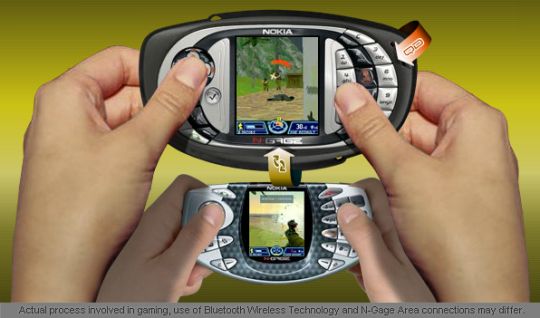
Mostly, I just wanted to use this picture from the Nokia website.
The N-Gage was a deliberate attempt to meld a handheld games console to a mobile phone, and was first released in 2003, to almost universal scorn. And quite rightly so - the initial model was a big, clunky monstrosity with a bucketful of ludicrous design flaws, most notably that if you wanted to change games, you had to switch off and dismantle half the machine, including removing the batteries, in order to get at the game port. The N-Gage was also a horrible phone, which you had to hold side-on to your head to talk into, looking a proper Charlie in the process. Throw in an initial price tag of £300 and it wasn't hard to explain why it sold so few units that Nokia wouldn't even tell anyone the sales figures for fear of causing a catastrophic collapse in their share price.
After waiting a few months for gamers to stop laughing and pull themselves together, the company came up with a redesign. Out went the need to pull the machine to bits to change games (now you didn't even need to switch the power off, a one-up on the likes of the Game Boy), out went the stupid sideways phone-talking, and out went a few extraneous features in order to make the phone a lot smaller and cuter. Suddenly, the N-Gage QD (the new model's name) was a halfway-desirable piece of kit, but it was too late for the fashion-conscious market and even the new pretty model died something of a death. Which is, of course, great news for gamers, as it means you can now pick one up for a fraction of the original cost. (WoS bought its QD for £79 from Comet with no games, but at the time of writing various other places will also flog you a "SIM-free" one - which you can simply transfer the SIM card from your current phone into, without needing a new contract or number - for the same sort of price, or for £99 with a game of your choice.)
But is it worth it? After all, there's rarely much of a future in buying bargain-bin end-of-line games machines, as anyone who picked up a cheap Atari Lynx will tell you. The N-Gage's dedicated software line-up is pretty thin, comprising just 40 or so titles, and there isn't much in the pipeline. However, the N-Gage has a future-proofing secret weapon, in the shape of its compatibility with both the Java standard and the Symbian operating system, which ensure that it'll run a dizzyingly vast array of games written for all manner of current and future phones. As a bonus, most of these games are dirt cheap (a fiver is the typical price), and it's those that we're mainly going to look at on the rest of this page.
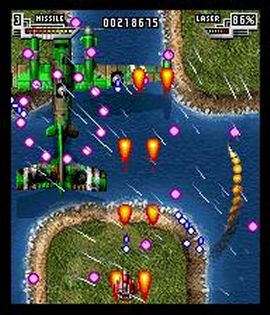 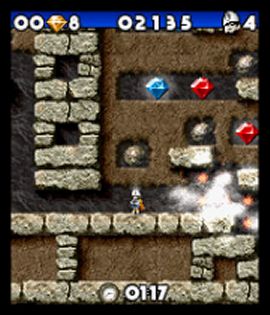
(Left) Gorgeous vertical shooter Sky Force. (Right) Slick Boulder Dash clone Super Miners.
(skip technical guff and get on with the rest of the feature)
The biggest problem that your intrepid correspondent faced, having bought his N-Gage and got a big bunch of games for it, was how to get the pesky things actually loaded onto the machine and running, for such information is documented absolutely nowhere, either on the Internet, in the N-Gage's highly unhelpful manual, or in the real world. But after a very considerable amount of research and blind trial-and-error, your reporter has managed to put together this comprehensive guide. WoS braved a great many illiterate chavs and incomprehensible txtspk messageboards before giving up and figuring most of this out for itself, so be grateful that you don't have to.
YOU WILL NEED:
- An MMC memory card. You should be able to pick up a new 256MB one of these on eBay for £15 or less, or a 512MB for around £20. Alternatively, get them in any high street electronics store (eg Dixons) for about twice as much.
- An MMC memory card reader/writer. Stores will try to charge you £25 for these, but you can easily get a brand-new one on eBay for a tenth of that.
- A free copy of FExplorer, downloadable from here (right-click and Save As).
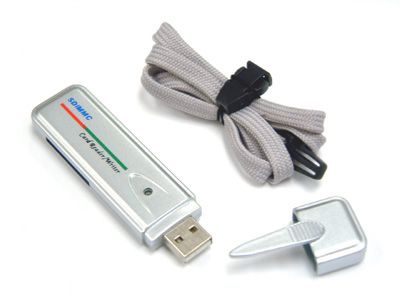
Your reporter's MMC writer looks like this, and was for sale at
the time of writing on eBay with a "Buy It Now" price of £3.50.
NB: There are other ways of getting software onto the N-Gage, such as transferring it by Bluetooth or down a special N-Gage USB cable using free Nokia software called PC-Suite, but the MMC-card method is both the easiest and the cheapest, and is the only one we'll be dealing with here, since to use the N-Gage as a gaming machine in any remotely sensible way you'll need to have an MMC card anyway.
1. The first thing you'll have to do is format your MMC card. Plug it into the N-Gage, and if you're not automatically prompted, go to Tools>>Memory>>Options and select Format.
2. With your card formatted, you can now copy N-Gage applications and games directly onto it from your PC, via the MMC card reader, by a simple drag-and-drop operation. However, the N-Gage inexplicably doesn't contain any method for reading the files off the memory card, so you'll need a file manager. Drag and drop FExplorer into the root directory of the memory card. This should cause it to appear on the N-Gage's main menu, and running it will enable you to access anything else you might upload onto the card. (The memory card will show up as drive E: in the N-Gage, with the machine's inbuilt memory obviously being the C: drive.)
3. Now we need to know what to do with the files we've got. N-Gage software comes in four basic forms:
(i) .SIS files. These are the equivalent of a SETUP.EXE file on a PC. Just run them with FExplorer from anywhere on the N-Gage and they should automatically install whatever software they contain, which should then appear on the main N-Gage menu.
(ii) .JAD and .JAR files. These are Java files, and the smaller .JAD is the one you want. If you run that, the N-Gage should ask you if you want to install the application. When it's done, the application will appear NOT on the main menu, but under Extras>>Apps.
NOTE: If you only have a JAR file and no JAD file, you'll need to create the JAD file yourself, as unlike other phones, the N-Gage has no idea what to do with a JAR on its own. But thanks to your pals here at WoS, JAD-file creation is just a couple of mouse-clicks away. First, you'll need a copy of JADMaker, which we've helpfully located here. Unzip JADMaker onto your PC, run it, and drag-and-drop the JAR file onto it. It'll automatically make you a JAD file..
(iii) .BLZ files. These are specially compressed files which need a special program called Blizzard Installer to uncompress and install them, which you can find here. Once you've installed Blizzard, put the .BLZ files in the root directory of the MMC card. When you run Blizzard, it will then automatically detect them, and give you the choice of which ones you want to install. Again, when done the applications will appear in the main N-Gage menu.
(iv) Finally, you may find some applications in the form of an archive containing file folders. Typically, the .ZIP or .RAR will contain several nested folders, usually called "SYSTEM", "APPS", "LIBS" or one of a couple of others, with various things inside them. These mirror the file structure created when formatting the memory card. Therefore, if your zipfile contains a folder called "APPS", copy the contents of that folder into the SYSTEM>>APPS folder on the card. If there's also a folder called "LIBS", copy the contents of that into SYSTEM>>LIBS on the card and so on. These applications will also appear on the main N-Gage menu when installed.
IMPORTANT: Do NOT change the names of any of the folders, or they may not show up on the menu, and may not work at all even if run directly from the file manager. "Snakes" might be a nicer-looking name for a folder than "6R45", but it'll break the game.
Between them, the above steps should take care of any file format you might encounter for running games and applications on your N-Gage.
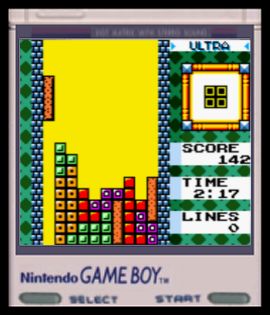 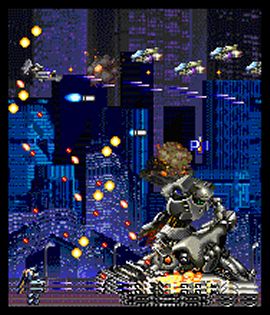
(Left) Tetris DX on GB emulator Vboy. (Right) Frenetic horizontal mecha shmup Matrix Fire.
So is it all actually worth it? Heck yes. An N-Gage with a fully-loaded memory card can pack more portable gaming power into your pocket than anything on Earth, even including a GBA SP with a Flash cart (not least because a 512MB MMC card is 512 megaBYTES, not megaBITS, and therefore has eight times the capacity of a GB Flash cart). The machine plays host to some excellent emulators, most notably Vboy, a Game Boy/Game Boy Color emu that boasts good compatibility and full speed with sound on most games, and EEMAME, already a great version of the classic arcade emu (albeit only really capable of playing the first-generation coin-ops) and getting better all the time.
A fair proportion of the dedicated N-Gage-only titles are pretty good too, such as speedy hedgehog-fest Sonic N, atmospheric FPS Ashen (there's also a very good port of Doom available), the challenging Colin McRae Rally 2005 and the thrilling Asphalt Urban GT, a superfast Burnout-esque racing game which features a track set in the bleak radioactive wastelands of Chernobyl. Most of the games were originally released with ridiculous £35 price tags, but you should be able to pick most of them up for a lot less than that now.
The best value for your gaming pound, however, comes in the huge raft of Java and Symbian games that can be bought on the web for between £3 and £9 a shot, with most being in the low-to-middle part of that range. Tiny enough not to hog too much of your memory card (most weigh in at 1MB or much less, compared to the 5MB - 40MB of dedicated N-Gage games), yet often matching their much more expensive counterparts every step of the way in both the graphics and gameplay departments, there are more little diamonds here than we could possibly list, but you shouldn't miss the likes of MicroPool (a brilliant five-minute bus-queue timekiller, and a snip at just $5, or about £2.70); the highly entertaining Stunt Race FX-ish Stunt Car Extreme; the stunning-looking shmup Sky Force; or the giant-robot stomparama Metal Bluster.
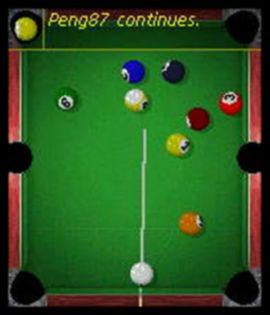 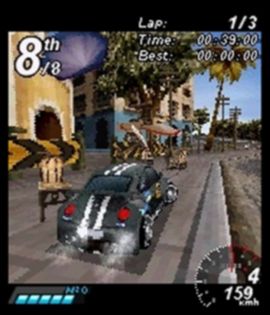
(Left) Fantastic pool sim MicroPool. (Right) Exciting high-speed racer Asphalt Urban GT.
It's not just in the value-for-money stakes that the N-Gage excels as a portable gaming console, though. (It's worth noting in passing that the machine itself is a joy to use - the horizontal orientation makes it much more comfortable to hold than a normal phone, and unlike most other phones it's happy recognising more than one keypress at a time, although Java games tend to only use one anyway.) Fans of the rare and obscure will be in hog heaven here. One particularly interesting little quirk is that because of the N-Gage's multi-standard compatibility, it can actually play host to completely different games with the same title. Below, for example, you'll find pictures of two entirely different FIFA 2004s, one the dedicated N-Gage version and one the N-Gage compatible Java version. Similarly, Colin McRae Rally fans can either try the 3D, Playstation-style N-Gage incarnation, or an overhead-view Java game reminiscent of Powerdrive on the Jaguar.
Conversely, the N-Gage and Java renditions of Prince Of Persia: Sands Of Time are near-identical, despite one of them costing roughly seven times as much as the other - partly because the N-Gage-only version comes on its own MMC card, of course, but there's still a heck of a markup going on. (Prince Of Persia fans are especially well-catered for, in fact - there are at least four PoP games playable on N-Gage, including both versions of Sands Of Time, plus Prince Of Persia Warrior Within and Prince Of Persia Harem Adventures, both in the cheap Java format.)
 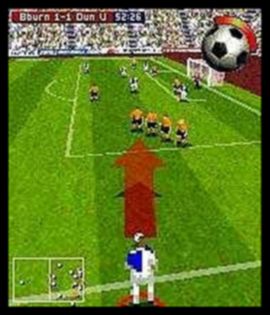
(Left) The cheap Java FIFA 2004. (Right) The fancy 3D expens-o-version.
And many other popular franchises have obscure releases on phone format too - ever played Worms Golf, for example? Or maybe Pitfall Jungle (a crude but playable little blocky platformer, also with a "Glacier" brother), or Taito's mobile version of Arkanoid, featuring new levels and powerups. Or Metal Slug Mobile (an all-new game in the style of the Neo Geo Pocket versions), or Galaxian Mini (er, don't bother with this one - it's an disgrace to the lineage, with a maximum of only three aliens onscreen at any time).
Perhaps best of all, though, are the just plain weird. The sheer dogged refusal of French cartoony Dance Dance Revolution wannabe Magic Dance Floor ("You are in the dancer's skin") to stop once you've started playing it can only be admired. Even more, your correspondent particularly enjoys Pop Idol Upstaged, a seemingly officially-licenced and tremendously unsound game where, as a hefty bouncer, you have to prevent young girls from climbing onto the stage while the Idol sings via a frankly disturbing arsenal of pushes, throws, headlocks and chucking buckets of water into the crowd, while also intercepting missiles hurled at the plucky performer.
And frankly, viewers, the less that's said about Ryan Giggs Pinball Challenge, which this reporter is not making up, the better things will be for everyone.
So what is it that we're trying to tell you here, viewers? Well, it's this: you can shove your PSP up your arse. The soul of videogaming needs a shrunken PS2 playing shrunken PS2 games like it needs a nail in its lungs. The future does not lie in spending an entire Aberdeen-to-Penzance rail journey slogging through miserable licence tests in Gran Turismo Mobile. It lies in absurdly entertaining five-minute blink-and-you-missed-them bursts of dozens and dozens of breathtakingly different games, all picked up for three or four quid like the glory days of Speccy budget ranges. The future is the past. The future - and who'd ever have thought they'd live to hear anyone say this, folks? - is an N-Gage.
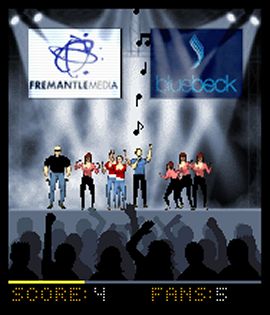 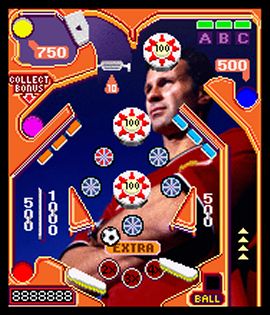
These pictures speak for themselves.
|

